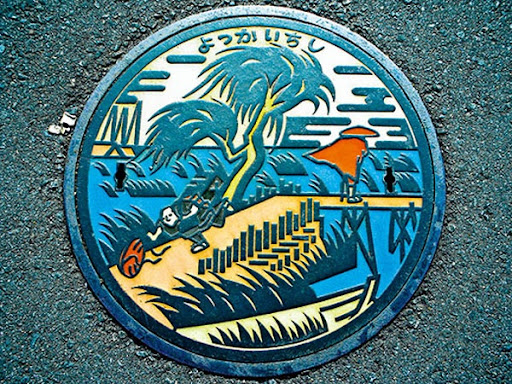An article at CNN examines a new book, 'Drainspotting', which deals with the introduction and growth of - of all things! - artistically-designed and -manufactured manhole covers in Japan. It's oddly fascinating. From the article:
Remo Camerota first caught CNNGo's attention with his documenting of Japanese graffiti. Now he says, "I follow this topic of a more conservative form of urban art, yet avant garde and bizarre in its very nature, it's industrial design yet japanese pop culture.
"Japan's manhole covers often include a symbol specific to an area or town as part of the overall design. For example, in Kora Town, Shiga, they feature a turtle (a symbol of wisdom and longevity) for the main motif, in addition to local landmarks, festivals, trees, myths, fireworks, boats, rivers, fish and sea creatures. Fairy tale elements, dinosaurs, anime characters, or icons can all be incorporated."
. . .
In his book, "Drainspotting," Remo discovers a variety of designs. He says, "I endeavor to describe some of them in detail with their symbol, meaning and location. I became a drainspotter purely by chance. While photographing 'Graffiti Japan' I would encounter these wonderful pieces from town to town, and I often side-tracked from the graffiti to photograph these works of art, collecting them one by one, which turned out to be like a treasure hunt and an obsession wanting to collect them all."
There are over 500,000 physical manholes in Tokyo and even though Japanese custom-made manhole covers cost more than generic ones, nearly 95 percent of the 1,780 municipalities in Japan sport their own specially designed manhole covers. "There are approximately 2,700 designs that we know of spread throughout Japan," says Remo, "which would mean that we would have to have many books to find them all."
The art of the hole, as it were, is something that has reached the point of a national obsession in Japan with numerous municipal departments competing against each other in the pursuit of the perfect manhole cover. The designs are not commissioned from artists, they are manufactured by a municipal foundry where they are cast and created. The City or Council will submit their ideas and symbol of choice to the foundry and their in-house designers will then create a design based on these specifications, going back and forth until the design is approved. Once right they will then cast a prototype before doing the final cast. These manhole covers are made of metal, whereas those found in Europe are generally constructed of pre-cast concrete. The metal lends itself to art in a much more subtle way. The colors are particularly striking which may appear garish to some eyes but not so to the Japanese who prefer vivid hues.
. . .
The art of the manhole cover may be considered low art by some, but it has reached a cult status to drainspotters around the world, with websites growing on the Internet highlighting these designs and where to find them, groups on Flickr dedicated to them and even some sewerage water treatment museums showcasing examples.
"It's innovative way to brighten up an urban area and cheer up its citizens in an unobtrusive, humble and uniquely Japanese way," says Remo.
There's more at the link. The photographs are drawn from Mr. Camerota's blog, also titled 'Drainspotting'. It's also worth reading, particularly for the many images provided.
Weirdly fascinating, aren't they?
Peter




5 comments:
Yet another thing ti kuje about the Japanese. Very cool!
The Japanese culture is just weird.
If they did that here, would teenagers steal them as souvenirs like road signs?
MechAg94
Yep, they are all over Japan, and the ONLY reason they aren't stolen is they weigh about 50 lbs apiece... :-)
Nice post ! i think that it's too heavy to be stole.
Post a Comment